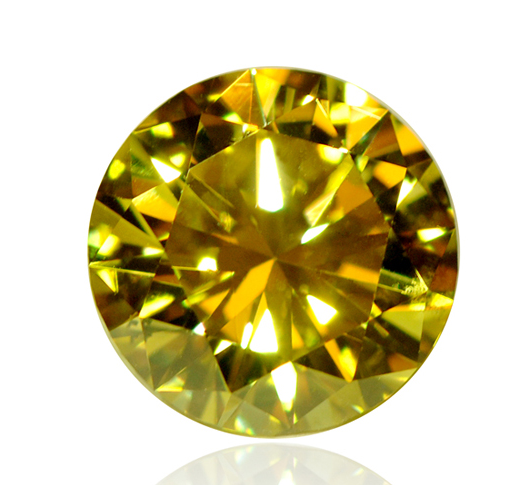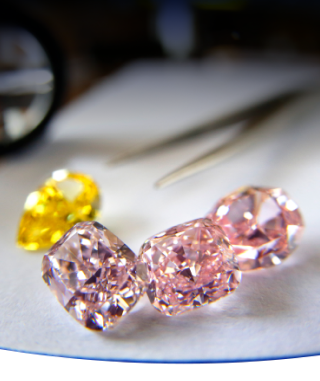The FCRF continually brings members the highest quality data to add more talking points to the fancy color diamond sales process. As part of these efforts, we have asked a preeminent diamond expert to shed light on one of the most desirable items in the fancy color world: the exceptional Vivid Yellow diamonds that are mined near the small village of Zimmi in Sierra Leone. This article explains why these stones have unique saturation that fetches extremely high prices.
Daniel Howell Ph.D.
Chief Scientist and Co-Founder,
Diamond Durability Laboratory
Nitrogen is almost ubiquitous in diamonds, so much so that its rare absence is highly sought after in gem diamonds. Some estimates suggest that over 98% of diamonds contain detectable amounts of nitrogen. As a result, diamonds are classified based on the characteristics of the nitrogen they contain. The valuable colorless Type II diamonds have a nitrogen content of less than 10 parts per million, meaning that for every 1 million carbon atoms that make up the diamond, there are fewer than 10 nitrogen atoms present. Type I diamonds have been reported to contain up to 5000 parts per million (0.5%; average values ~200-300 ppm).
While nitrogen accounts for the yellow color in diamonds, it is the way in which the nitrogen is bound in the diamond that causes their color. When nitrogen is incorporated into a diamond, a single nitrogen atom takes the place of a single carbon atom. Diamonds containing nitrogen in this form are classified as Type Ib. They exhibit a yellow color because the single nitrogen atoms absorb light in the violet and blue portion of the spectrum, resulting in a visible yellow color.

In the old world, this color was commonly referred to as canary yellow due to its unique, strong yellow saturation. More recently, the term Zimmi has entered into the gem industry’s lexicon to refer to these yellow Type Ib diamonds. This refers to the Zimmi mining area in southern Sierra Leone which has become an important source for these diamonds. However, Type Ib yellow diamonds can also originate in other places.
At the high temperatures and pressures that diamonds experience deep within the Earth (~1000 – >1200oC), the single atoms of nitrogen are mobile within the diamond lattice. This means they can move around until they meet another nitrogen atom, changing the diamond’s classification from Type Ib to Type IaA. This pair of nitrogen atoms does not absorb light like single atoms, and therefore the yellow color is lost. This process of nitrogen moving around the crystal and pairing up is called nitrogen aggregation, and depends on three factors; (i) the amount of nitrogen in the diamond, (ii) the amount of time the diamond resided within the Earth, and (iii) the diamond’s temperature when it resided in the Earth. Given the high temperatures noted above, the time needed for the nitrogen to aggregate into pairs is very short, typically less than one million years. When we consider that scientific research into diamonds’ ages shows that they can reside in the Earth for anywhere from one million to a few billion years, it is clear why Type Ib diamonds are so rare. A 2005 study by the GIA [2] further underscores this rarity. They reviewed over 10,000 yellow diamonds submitted to the GIA in two non-sequential years and found that Type Ib diamonds represented just 0.8% of them.
Two recent studies by GIA scientists [3,4] shed light on Type Ib diamonds specifically from Zimmi, adding a whole new dimension to their rarity. They reported total nitrogen concentrations ranging from 8 to ~340 ppm, with the amount of single nitrogen atoms ranging from 8 to ~40 ppm. The nitrogen aggregation model suggests that these diamonds either had a very short residence within the Earth, or that once they grew, they were moved to a shallower (and therefore cooler) part of the Earth, residing there for a potentially long time. Given that from a geological perspective, the likelihood of this second option is rare, many diamond scientists lean towards the first conclusion. In the case of Zimmi diamonds, the first conclusion would appear to be wrong.
Dr Karen Smit of the GIA recently published data [4] from sulfide inclusions in Zimmi Type Ib diamonds indicating that they are ~650 million years old. Considering that the volcanic eruptions that brought these diamonds to the surface took place around 150 million years ago, their lack of aggregation suggests that very soon after the diamonds formed, they were transported to a shallower and cooler (less than 850°C) depth in the Earth. They would have had to have resided there for nearly 500 million years before being brought up to the surface in a volcanic eruption.
The fact that the nitrogen aggregation process changes the single nitrogen atoms responsible for the yellow color in Type Ib diamonds in a very short time at high temperatures deep in the Earth, combined with the diamonds’ vast age, makes these particular yellow diamonds extremely rare. The initial hypothesis that these diamonds did not reside in the Earth for long and can be considered a young relative of more ancient diamonds is not a bad one. Yet the recent GIA study on Type Ib yellow Zimmi diamonds shows that this may not always be the case, and that they are possibly even more special. They have survived residing in the shallower part of the Earth for half a billion years without turning to graphite while also retaining their valuable color. This is quite a feat, and highlights another reason why this type of yellow diamond is so unique.
1 Shigley, J.E., 2005. Elements, 1, 101-104.
2 King et al., 2005. Gems & Gemology, 41, No. 2, pp. 88–115
3 Shigley, J.E. & Breeding, C.M., 2013. Gems & Gemology, 49 (4), 259-260.
4 Smit, K., Shirey, S.B. & Wang, W., 2016. Type Ib diamond formation and preservation in the West African lithospheric mantle: Re-Os age constraints from sulphide inclusions in Zimmi diamonds. Precambrian Research, in press.

